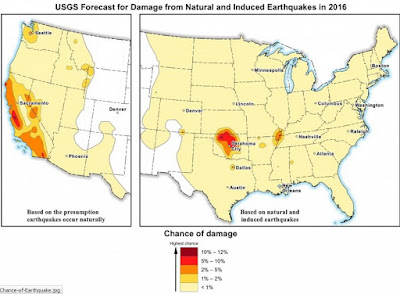# 11,205
Over the past few years we've looked repeatedly at the remarkable increase in earthquake activity in Oklahoma and several surrounding states, much of which has been attributed to waste water disposal through injection wells.
The number of M3.0+ earthquakes in 2015 ( n=1,010) was more than 40 times the average seen between 1973 and 2008.
You can find some of my earlier blogs on Oklahoma’s growing earthquake problem at:
USGS/OGS Joint Statement On Increased Earthquake Threat To Oklahoma
USGS: Oklahoma Earthquake Swarm Update
Oklahoma Insurance Commissioner Warns On Earthquake Risks
Today the USGS released their first report and risk map for induced earthquakes, primarily in six Midwestern states (Oklahoma, Kansas, Texas, Colorado, New Mexico, and Arkansas), that have the potential to affect the roughly 7 million people who live and work in those regions.
In some of these regions, the risks for damaging earthquakes are as great as in the highest risk regions of California.
You'll find more details on the USGS website:
Induced Earthquakes Raise Chances of Damaging Shaking in 2016
Posted on March 28, 2016 at 11:50 am
By: Jessica Fitzpatrick (jkfitzpatrick@usgs.gov) and Mark Petersen (mpetersen@usgs.gov)
For the first time, new USGS maps identify potential ground-shaking hazards from both human-induced and natural earthquakes. In the past, USGS maps only identified natural earthquake hazards.
This is also the first one-year outlook for the nation’s earthquake hazards, and is a supplement to existing USGS assessments that provide a 50-year forecast
The report shows that approximately 7 million people live and work in areas of the central and eastern U.S. (CEUS) with potential for damaging shaking from induced seismicity. Within a few portions of the CEUS, the chance of damage from all types of earthquakes is similar to that of natural earthquakes in high-hazard areas of California.
“By including human-induced events, our assessment of earthquake hazards has significantly increased in parts of the U.S.,” said Mark Petersen, Chief of the USGS National Seismic Hazard Mapping Project. “This research also shows that much more of the nation faces a significant chance of having damaging earthquakes over the next year, whether natural or human-induced.”
Inuced earthquakes are triggered by human activities, with wastewater disposal being the primary cause for recent events in many areas of the CEUS. Wastewater from oil and gas production operations can be disposed of by injecting it into deep underground wells, below aquifers that provide drinking water.
(Continue . . . )
The State of Oklahoma maintains an earthquake safety webpage at EARTHQUAKE SAFETY, while additional Oklahoma specific earthquake monitoring and research information can be found at the Oklahoma Geological Survey.
At a bare minimum, every household should have a disaster plan, a good first aid kit (and the knowledge to use it), an emergency battery operated NWS weather radio, and emergency supplies to last a minimum of 72 hours during a disaster.To become better prepared as an individual, family, business owner, or community, I would invite you to visit the following preparedness sites.
A reminder that no matter where you live, it pays to be prepared. And as we discussed on Sunday, cold weather can make dealing with any disaster situation all that much tougher.
For more on increasing your level of preparedness, a partial list of some of my preparedness blogs include:
FEMA http://www.fema.gov/index.shtm
READY.GOV http://www.ready.gov/
AMERICAN RED CROSS http://www.redcross.org/
When 72 Hours Isn’t Enough
In An Emergency, Who Has Your Back?
#NatlPrep: Half Of All Americans Need An Earthquake Plan
